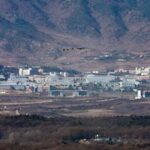
While North Korea has maintained a low-key approach instead of provoking South Korea amid its martial law fallout, speculation is growing that it may soon launch a new intermediate-range ballistic missile (IRBM) targeting Guam, a U.S. territory.
With North Korea’s year-end plenary meeting approaching and the inauguration of the new U.S. administration imminent, analysts suggest the regime may use the opportunity to showcase its achievements and assert its presence through a missile provocation.
South Korea’s Joint Chiefs of Staff (JCS) briefed the country on Monday: “Considering recent indications of solid-fuel ballistic missile production and movement, North Korea’s Five-Year Defense Development Plan, and domestic and international political events such as the U.S. presidential inauguration, there is a possibility that North Korea could conduct a surprise launch of an IRBM or hypersonic missile around the Workers’ Party plenary meeting.”
In January 2021, North Korea introduced its Five-Year Defense Development Plan during the 8th Congress of the Workers’ Party.
One of the plan’s five core tasks, which Kim Jong Un highlighted, was developing and deploying hypersonic glide warheads.
Notably, the hypersonic glide vehicle is one of the five core tasks related to the defense development plan, and it is a weapon system that Kim Jong Un specifically requested for development and introduction.

North Korea has consistently developed hypersonic and solid-fueled missiles, but it only applied all relevant technologies to IRBMs for the first time this past January. Three months later, North Korea unveiled a new IRBM equipped with a glider-type hypersonic glider, departing from the previous cone-shaped design.
In fact, North Korean media reported that under Kim’s supervision, the first test launch of the new medium-range solid-fueled ballistic missile Hwasong-16na took place on April 2.
The media stated, “To ensure safety during the new weapon system’s first test launch, we limited the range to within 1,000 km. We implemented a delayed ignition of the two-stage engine and forced restrictions on speed and altitude by rapidly changing the flight trajectory during the active phase. This confirmed the hypersonic glide vehicle’s gliding leap flight path characteristics and lateral maneuverability.”
As it was the first launch, they focused on verifying the regular operation of the irregular maneuver without maximizing engine capabilities. North Korean media reported that agile and superior maneuverability characteristics were confirmed.
However, South Korea’s JCS dismissed the claims as exaggerated, stating, “The North’s claims that it intentionally delayed the ignition of the second-stage engine and changed the flight direction during the second-stage engine burn do not align with our analysis.”
Some have criticized the South Korean military’s analysis, pointing out that the stated flight range of 600 kilometers suggests it may have failed to detect the missile’s abnormal maneuvers accurately.

If North Korea conducts another IRBM launch as expected, analysts believe it will likely emphasize extended range and performance enhancements compared to the initial test in April.
Unlike in April, if the solid-fuel engines perform at full capacity, North Korea can operate solid-fuel ballistic missiles across all ranges.
The South Korean military assesses that short-range solid-fuel ballistic missile development is virtually complete. In contrast, progress in long-range missiles has advanced significantly, as demonstrated by the successful launch of the Hwasong-19 intercontinental ballistic missile (ICBM).
However, the military maintains that North Korea’s reentry technology for medium- and long-range missiles requires further verification, which would necessitate a normal-angle test launch.

Although it may take time for these missiles to be fully deployed, North Korea’s expansion of its solid-fuel ballistic missile arsenal poses a direct threat to South Korean security.
Liquid-fuel ballistic missiles require a fueling process that makes detection easier, whereas solid-fuel missiles are detachable and more advantageous for surprise launches. This drastically shortens the response time for South Korea, the United States, and Japan to detect and counteract launch signals.
Moreover, when combined with North Korea’s strategy of diversifying launch origins using mobile launchers (TELs), the country’s ability to conduct surprise nuclear strikes is expected to grow stronger.















Most Commented